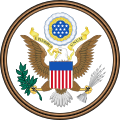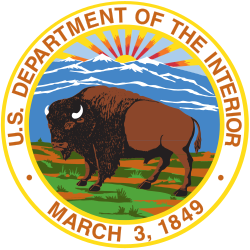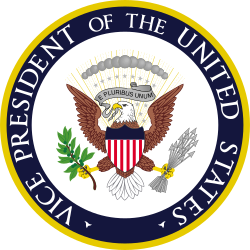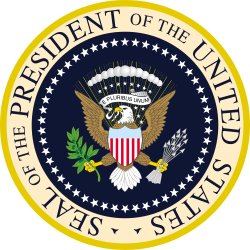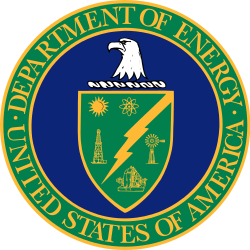Office of Management and Budget
Office of Management and Budget | |
|---|---|
 | |
| Staatliche Ebene | Bund |
| Aufsichtsbehörde | Executive Office of the President of the United States |
| Gründung | 1970 |
| Hauptsitz | Eisenhower Executive Office Building, Washington, D.C. |
| Behördenleitung | Russell Vought |
| Bedienstete | 500 |
| Netzauftritt | www.whitehouse.gov/omb |
Das Office of Management and Budget (OMB, deutsch etwa Amt für Verwaltung und Haushaltswesen) ist eine US-Bundesbehörde mit Kabinettsrang und die größte Behörde im Executive Office of the President of the United States (EOP).
Tätigkeitsbereich
Das OMB berichtet dem Weißen Haus über die Aktivitäten aller Bundesbehörden. Außerdem berät das OMB die Beamten des Hauses in Themen wie Bundespolitik, Verwaltung, Gesetzgebung und der Haushaltsführung. Das Gros der 500 Mitarbeiter überwacht die Einhaltung und Befolgung der ihnen zugeteilten Bundesprogramme im Sinne der Politik des Präsidenten. Außerdem hat das OMB eine wichtige Rolle als koordinierende Behörde: unter anderem bei der jährlichen Sammlung und Bekanntgabe der Budgetermessung des Präsidenten, bei der Versendung von Rundbriefen an alle Bundesbehörden, in denen neue Verfahren für die Leitung vorgeschrieben werden, bei der Beaufsichtigung der Management Agenda des Präsidenten und bei der Überprüfung von Richtlinien in den Behörden.
Mitarbeiter
Die Mitarbeiter des OMB sind nicht nur hochgediente Verwaltungsbeamte, sondern auch zum Teil aus politischen Gründen ernannt. Die Mitarbeiter des OMB sind ein wichtiger Teil der Kontinuität in der Exekutive, insbesondere weil die meisten der Karrierebeamten ihre Posten behalten, egal welche Partei im Moment im Haus das Sagen hat.
Sechs Positionen im OMB werden vom Präsidenten ernannt und vom US-Senat bestätigt:
- der Direktor
- der stellvertretende Direktor
- der Bereichsleiter Management
- und die Leiter der Abteilungen Office of Information and Regulatory Affairs, Office of Federal Procurement Policy, und Office of Federal Financial Management
Nach dem Wechsel von Sylvia Mathews Burwell in das Amt der Gesundheitsministerin der Vereinigten Staaten führte ihr Stellvertreter Brian Deese interimsmäßig die Behörde, ehe im Juli 2014 Shaun Donovan sein Amt antrat.
Aufbau der Behörde
Der größte Teil des OMB sind die vier Abteilungen der Betriebsmittelverwaltung, die die US-Bundesregierung widerspiegeln. Schätzungsweise arbeitet die Hälfte der Mitarbeiter in diesen Abteilungen, die Mehrheit von ihnen arbeitet wiederum als Programmrevisoren. Diese Programmrevisoren überwachen in der Regel eine oder mehrere Bundesbehörden, oder sie kontrollieren ein bestimmtes Themenfeld, wie zum Beispiel alles, was die Kriegsschiffe der US Navy betrifft.
Diese Mitarbeiter des OMB haben eine zweifache Zuständigkeit, einerseits für alle Themen rund um das Management und den Haushalt, und andererseits sollen sie fundierte Empfehlungen zu den Programmen abgegeben. Jedes Jahr werden vom OMB die Budgetanforderungen der Bundesbehörden durchgesehen, und es wird auf diese Weise bei der Entscheidung, welche dieser Anfragen als Teil des Präsidentenhaushalts zum Kongress geschickt werden, geholfen.
Angewendet werden hierbei detaillierte Programmbewertungen, bei denen das Program Assessment Rating Tool[1] verwendet wird, von den Behörden vorgeschlagene Regeln werden bewertet, ein Zeugnis der Behörde wird verwendet, schwebende Gesetzgebung wird berücksichtigt, und die Anfragen werden mit den Zielen der Management Agenda des Präsidenten verglichen.[2] Außerdem bietet das OMB jedem Kabinettsmitglied spezielle Analysen an.
Auch die Mitarbeiter der untergeordneten Behörden Office of Information and Regulatory Affairs, Office of Federal Procurement Policy, Office of Federal Financial Management und Office of E-Government erhalten vom OMB Statistiken, Analysen und Daten. Weiterhin gibt es verschiedene unterstützende Ämter wie das Office of General Counsel, das Office of Legislative Affairs, die Budget Review Division (BRD) und die Legislative Reference Division.
Das BRD ist größtenteils für die bundesweite Koordinierung sowie für die technische Seite der Budgethochrechnungen, die jeden Februar veröffentlicht werden, verantwortlich. Bezüglich der Ausgabenschätzung für die Exekutive, hat das BRD somit denselben Zweck wie das Congressional Budget Office für die Ausgabenschätzung des Kongresses, das Department of the Treasury für die Schätzung der Einnahmen der Exekutive, und das Joint Committee on Taxation für die Schätzung der Einnahmen des Kongresses.
Die Legislative Reference Division nimmt die wichtige Rolle der zentralen Clearingstelle für beantragte Gesetzgebung in der gesamten Bundesregierung ein. Sie verbreitet die beantragten Gesetzesinitiativen an die zuständigen Bundesprüfer und fasst deren Kommentare zusammen. Außerdem fällt es in den Zuständigkeitsbereich dieser Behörde, für den Präsidenten ein Enrolled Bill Memorandum zu schreiben, sobald von beiden Kammern ein Gesetzesentwurf dem Präsidenten zur Unterschrift vorgelegt wird.
Die Enrolled Bill Memorandum stellt dabei die Einzelheiten dieses Entwurfs, die Meinungen verschiedener, vom Gesetzentwurf betroffener Bundesministerien, und eine abschließende Meinung über eine Unterschrift oder ein Veto zu diesem Entwurf zusammen. Außerdem veröffentlicht diese Abteilung die Statements of Administration Policy, die für die Kongressabgeordneten die offizielle Meinung des Weißen Hauses zusammenfassen.
Geschichte
Das Bureau of the Budget, Vorgängerin dieser Behörde, wurde als Teil des Finanzministeriums 1921 im Rahmen des Budget and Accounting Act geschaffen. Im Jahr 1939 wurde es dem Executive Office of the President zugeordnet; 1970 wurde es als Office of Management and Budget neu formiert. Das erste OMB bestand aus dem Direktor Roy Ash, seinem Stellvertreter Paul O’Neill, dem Abteilungsleiter Fred Malek, dem zweiten Abteilungsleiter Frank Zarb und rund zwei Dutzend weiteren Mitarbeitern. Im Jahr 1990 wurde das OMB umgebaut, um die Unterschiede zwischen den Mitarbeitern der Verwaltung und denen des Haushalts abzuschaffen. Diese Rollen wurden in den Ressource Management Offices nun durch die Programmrevisoren vereint.
Die Direktoren des OMB
| Name | Dienstzeit ↓ | Präsident |
|---|---|---|
| Charles Gates Dawes | 23. Juni 1921 – 30. Juni 1922 | Warren G. Harding |
| Herbert Lord | 1. Juli 1922 – 31. Mai 1929 | Warren G. Harding, Calvin Coolidge, Herbert Hoover |
| Clawson Roop | 15. August 1929 – 3. März 1933 | Herbert Hoover |
| Lewis Williams Douglas | 7. März 1933 – 31. August 1934 | Franklin D. Roosevelt |
| Daniel W. Bell | 1. September 1934 – 14. April 1939 | Franklin D. Roosevelt |
| Harold D. Smith | 15. April 1939 – 19. Juni 1946 | Franklin D. Roosevelt, Harry S. Truman |
| James E. Webb | 13. Juli 1946 – 27. Januar 1949 | Harry S. Truman |
| Frank Pace | 1. Februar 1949 – 12. April 1950 | Harry S. Truman |
| Frederick Lawton | 13. April 1950 – 21. Januar 1953 | Harry S. Truman |
| Joseph Dodge | 22. Januar 1953 – 15. April 1954 | Dwight D. Eisenhower |
| Rowland Hughes | 16. April 1954 – 1. April 1956 | Dwight D. Eisenhower |
| Percival Brundage | 2. April 1956 – 17. März 1958 | Dwight D. Eisenhower |
| Maurice Stans | 18. März 1958 – 21. Januar 1961 | Dwight D. Eisenhower |
| David E. Bell | 22. Januar 1961 – 20. Dezember 1962 | John F. Kennedy |
| Kermit Gordon | 28. Dezember 1962 – 1. Juni 1965 | John F. Kennedy, Lyndon B. Johnson |
| Charles Schultze | 1. Juni 1965 – 28. Januar 1968 | Lyndon B. Johnson |
| Charles Zwick | 29. Januar 1968 – 21. Januar 1969 | Lyndon B. Johnson |
| Robert Mayo | 22. Januar 1969 – 30. Juni 1970 | Richard Nixon |
| George P. Shultz | 1. Juli 1970 – 11. Juni 1972 | Richard Nixon |
| Caspar Weinberger | 12. Juni 1972 – 1. Februar 1973 | Richard Nixon |
| Roy Ash | 2. Februar 1973 – 3. Februar 1975 | Richard Nixon, Gerald Ford |
| James Thomas Lynn | 10. Februar 1975 – 20. Januar 1977 | Gerald Ford |
| Bert Lance | 21. Januar 1977 – 23. September 1977 | Jimmy Carter |
| James T. McIntyre | 24. September 1977 – 20. Januar 1981 | Jimmy Carter |
| David Stockman | 21. Januar 1981 – 1. August 1985 | Ronald Reagan |
| James C. Miller | 8. Oktober 1985–15. Oktober 1988 | Ronald Reagan |
| Joseph R. Wright | 16. Oktober 1988 – 20. Januar 1989 | Ronald Reagan |
| Richard Darman | 25. Januar 1989 – 20. Januar 1993 | George Bush |
| Leon Panetta | 21. Januar 1993 – Oktober 1994 | Bill Clinton |
| Alice Rivlin | 17. Oktober 1994 – 26. April 1996 | Bill Clinton |
| Franklin Raines | 13. September 1996 – 21. Mai 1998 | Bill Clinton |
| Jack Lew | 21. Mai 1998 – 19. Januar 2001 | Bill Clinton |
| Mitch Daniels | 23. Januar 2001 – 6. Juni 2003 | George W. Bush |
| Joshua Bolten | 26. Juni 2003 – 15. April 2006 | George W. Bush |
| Rob Portman | 26. Mai 2006 – 19. Juni 2007 | George W. Bush |
| Jim Nussle | 4. September 2007 – 19. Januar 2009 | George W. Bush |
| Peter R. Orszag | 20. Januar 2009 – 30. Juli 2010 | Barack Obama |
| Jack Lew | 18. November 2010 – 27. Januar 2012 | Barack Obama |
| Jeffrey Zients | 27. Januar 2012 – 24. April 2013 | Barack Obama |
| Sylvia Mathews Burwell | 24. April 2013 – 9. Juni 2014 | Barack Obama |
| Brian Deese | 9. Juni 2014 – 28. Juli 2014 | Barack Obama |
| Shaun Donovan | 28. Juli 2014 – 20. Januar 2017 | Barack Obama |
| Mick Mulvaney | 16. Februar 2017 – 31. März 2020 | Donald Trump |
| Russell Vought | 22. Juli 2020 – 20. Januar 2021 | Donald Trump |
| Shalanda Young | 15. März 2022 – 20. Januar 2025 | Joe Biden |
| Russell Vought | ab 7. Februar 2025 | Donald Trump |
Weblinks
- Office of Management and Budget – Website der Behörde
- TheBudgetGraph.com Veranschaulichung des frei verfügbaren Bundeshaushalt für 2008
- "The Decision Makers: Office of Management and Budget" GovExec.com, August 22, 2005
- OMB Regulatory Officials By Administration
- History OMB Regulatory Review
- Management and Budget Office im Federal Register
Einzelnachweise
- ↑ The Program Assessment Rating Tool (PART). Abgerufen am 9. Januar 2016.
- ↑ http://georgewbush-whitehouse.archives.gov/results/
Auf dieser Seite verwendete Medien
Seal of the United States Department of Commerce.
The seal was approved on April 4, 1913 and is derived from the seal of the defunct United States Department of Commerce and Labor. It is composed of the arms (Per fesse azure and or, a ship in full sail on waves of the sea, in chief proper; and in base a lighthouse illumined proper), and crest ("The American Eagle displayed"). Around the arms, between two concentric circles, are the words "Department of Commerce" and "United States of America".
The official symbolism has been modified as the functions of the department have changed. As of 2007: the ship is a symbol of commerce; the blue denotes uprightness and constancy; the lighthouse is a well-known symbol representing guidance from the darkness which is translated to commercial enlightenment; and the gold denotes purity. The crest is the American bald eagle denoting the national scope of the Department's activities.
Full description at CFR Title 15 Part 1Seal of the United States Department of the Interior.
The seal consists of a male bison with the head and body in a left position, standing on a prairie, with mountains and a rising sun in the background, enclosed within two concentric circles, having the words "U.S. Department of the Interior" and the date "March 3, 1849" (when Congress created the department) inscribed in the top and bottom arcs within these circles. See here for more information.
The bison seal dates from 1917, when it was used as the emblem on the initial department flag and thereafter replaced the old version of the seal, which used a federal eagle. The eagle was reinstated for a few years in the 1920s, and a different seal was used from 1968-69, but on both occasions the bison seal was reinstated. For more information see this chapter in The Department of Everything Else: Highlights of Interior History.Seal of the Vice President of the United States. The blazon is defined in Executive Order 11884 as:
The design is the same as the Seal of the President of the United States, except that there is no ring of stars, the clouds are gray (instead of proper), the stars are gray (instead of argent), the scroll is gray (instead of white), the arrows are gray (instead of proper), and the background colors and inscription (obviously) differ.The Coat of Arms of the Vice President of the United States shall be of the following design:
SHIELD: Paleways of thirteen pieces argent and gules, a chief azure; upon the breast of an American eagle displayed holding in his dexter talon an olive branch proper and in his sinister a bundle of thirteen arrows gray, and in his beak a gray scroll inscribed "E PLURIBUS UNUM" sable.
CREST: Behind and above the eagle a radiating glory or, on which appears an arc of thirteen cloud puffs gray, and a constellation of thirteen mullets gray.
The Seal of the Vice President of the United States shall consist of the Coat of Arms encircled by the words "Vice President of the United States."
Seal of the United States Department of Homeland Security. A graphically styled American eagle appears in a circular blue field. The eagle's outstretched wings break through an inner red ring into an outer white ring that contains a circular placement of the words "U.S. DEPARTMENT OF" in the top half and "HOMELAND SECURITY" in the bottom half. The outer white ring has a silvery gray border. As in The Great Seal, the eagle’s left claw holds an olive branch with 13 leaves and 13 seeds while the right claw grasps 13 arrows. Centered on the eagle's breast is a shield divided into three sections containing elements that represent the homeland "from sea to shining sea." The top element, a dark blue sky, contains 22 stars representing the original 22 agencies and bureaus that have come together to form the department. The left shield element contains white mountains behind a green plain underneath a light blue sky. The right shield element contains four wave shapes representing the oceans, lakes and waterways alternating light and dark blue separated by white lines.
Seal of the United States Department of Housing and Urban Development.
The seal was originally unveiled on November 10, 1966, and later defined in law (Federal Register 32FR366-67 and 24 CFR subtitle A, §11.1, both since removed as part of a streamlining of the federal code). The seal was defined as:
On a white background within a circle composed of the words, "U.S. Department of Housing and Urban Development," is an eagle and two stars. The six upper bars depicting the upper portion of the eagle's wings, the torso of the eagle, the star at the right of the eagle, and the words, "U.S. Department of Housing and Urban Development," are colored blue. The eight lower bars depicting the lower portion of the eagle's wings and the star at the left of the eagle are colored green."
The seal is a representative of high rise buildings simulating an eagle and giving emphasis to the "urban" in HUD's name. The eagle (shown abstractly) is a symbol of Federal authority. The use of green symbolizes open space, land, growth and prosperity. The blue in the Seal alludes to the quality of life and environment in America's cities.
More information here.The seal of the United States Department of the Treasury.
The original seal dates from the Board of Treasury during the Articles of Confederation, and so predates the department (and Federal Government) itself. The current design is a slight simplification of the original, introduced in 1968.
The seal's arms depicts balancing scales (to represent justice), a key (the emblem of official authority) and a chevron with thirteen stars (to represent the original states).
For more information, see here.Seal of the United States Department of Justice.
The origins of the seal are unknown; it was first used in the 19th century as the seal for the Office of the Attorney General (prior to the formation of the Department of Justice) but the exact date is unknown. Even the translation of the Latin motto is murky, a matter of debate between Latin scholars. The Department's currently accepted translation is who prosecutes on behalf of Lady Justice, referring to the Attorney General. The motto is an allusion to the wording of the writ in a qui tam action: qui tam pro domino rege quam pro se ipso sequitur ("he who sues on behalf of our lord the King as well as for himself." The current-day seal dates from 1934, when some (though not all) of the heraldic mistakes on the original were corrected. More information here.The seal of the United States Department of Health and Human Services. The symbol represents the American People sheltered in the wing of the American Eagle, suggesting the Department’s concern and responsibility for the welfare of the people. The colors are reflex blue and gold.
This seal is now just used for mainly legal purposes; the department has a separate logo which is used for its visual identity.
More information here and here.Seal of the United States Department of Education.
The seal was introduced on May 7, 1980, and is described in law as:More information here and 34 CFR Part 3.Standing upon a mound, an oak tree with black trunk and limbs and green foliage in front of a gold rising sun, issuing gold rays on a light blue disc, enclosed by a dark blue border with gold edges bearing the inscription "DEPARTMENT OF EDUCATION" above a star at either side of the words "UNITED STATES OF AMERICA" in smaller letters in the base; letters and stars in white.
Seal of the US Environmental Protection Agency (EPA).
Seal of the United States Department of Transportation, introduced on 17 November 1980. The seal is described in 49 CFR 3.1 as 'A white abstract triskelion figure signifying motion appears within a circular blue field. The figure is symmetrical. The three branches of the figure curve outward in a counter-clockwise direction, each tapering almost to a point at the edge of the field. Surrounding the blue circle is a circular ring of letters. The upper half of the ring shows the words “Department of Transportation”. The lower half of the ring shows the words “United States of America”. The letters may be shown in either black or medium gray. The official seal of the Department is modified when embossed. It appears below in black and white.'
The creation of the new Department of Veterans Affairs in 1989 required a new official seal to represent VA. In November 1988, after the law establishing VA as a cabinet department was signed, VA initiated a competition among employees for a seal design that would give the new department a "new look." The winner of that competition, and creator of today's VA seal was David E. Gregory, a medical media production specialist at the Indianapolis VA Medical Center. These are the key elements of the seal, as he described them:
- The eagle represents the United States.
- The circle of five stars above the eagle represents the Army, Navy, Air Force, Marines and Coast Guard.
- The two flags in the eagle's talons represent the span of America's history from 13 colonies to the present 50 states.
- The flags are bound by a golden cord symbolic of those Americans who have fallen in service to their country.
- The eagle holds the cord to perpetuate the memory of those veterans who have fallen and sacrificed for the nation.
Seal of the United States Department of the Interior.
The seal consists of a male bison with the head and body in a left position, standing on a prairie, with mountains and a rising sun in the background, enclosed within two concentric circles, having the words "U.S. Department of the Interior" and the date "March 3, 1849" (when Congress created the department) inscribed in the top and bottom arcs within these circles. See here for more information.
The bison seal dates from 1917, when it was used as the emblem on the initial department flag and thereafter replaced the old version of the seal, which used a federal eagle. The eagle was reinstated for a few years in the 1920s, and a different seal was used from 1968-69, but on both occasions the bison seal was reinstated. For more information see this chapter in The Department of Everything Else: Highlights of Interior History.Seal of the United States Department of Commerce.
The seal was approved on April 4, 1913 and is derived from the seal of the defunct United States Department of Commerce and Labor. It is composed of the arms (Per fesse azure and or, a ship in full sail on waves of the sea, in chief proper; and in base a lighthouse illumined proper), and crest ("The American Eagle displayed"). Around the arms, between two concentric circles, are the words "Department of Commerce" and "United States of America".
The official symbolism has been modified as the functions of the department have changed. As of 2007: the ship is a symbol of commerce; the blue denotes uprightness and constancy; the lighthouse is a well-known symbol representing guidance from the darkness which is translated to commercial enlightenment; and the gold denotes purity. The crest is the American bald eagle denoting the national scope of the Department's activities.
Full description at CFR Title 15 Part 1Seal of the United States Department of Agriculture.
The USDA seal was created in 1895. It was adapted for use as a general identifier in 1980, but those usages were replaced with the USDA Logo in 1996. The seal has been withdrawn from use as a departmental identifier, though it is still used on legal materials and other internal uses.
The seal is defined as:Two and three-eights inches in diameter (azure), a shock of corn (or), upon a base (vert) an American plough proper. All within a double annulet (argent), outer roped, inner beaded, charged with the inscription: UNITED STATES DEPARTMENT OF AGRICULTURE, and at the base, a scroll bearing the legend: "1862.AGRICULTURE IS THE FOUNDATION OF MANUFACTURE AND COMMERCE. 1889." (or). A diapered background of 44 stars (argent) for the States of the Union.
The dates on the scroll represent the year the Department was founded by act of Congress (1862), and the year the Department was made an Executive Office headed by a Secretary of cabinet rank (1889). The 44 stars represent the states in the Union in 1889.
See here and here for more information.Seal of the United States Department of Defense from 2001 to 2022.
Seal of the Vice President of the United States. The blazon is defined in Executive Order 11884 as:
The design is the same as the Seal of the President of the United States, except that there is no ring of stars, the clouds are gray (instead of proper), the stars are gray (instead of argent), the scroll is gray (instead of white), the arrows are gray (instead of proper), and the background colors and inscription (obviously) differ.The Coat of Arms of the Vice President of the United States shall be of the following design:
SHIELD: Paleways of thirteen pieces argent and gules, a chief azure; upon the breast of an American eagle displayed holding in his dexter talon an olive branch proper and in his sinister a bundle of thirteen arrows gray, and in his beak a gray scroll inscribed "E PLURIBUS UNUM" sable.
CREST: Behind and above the eagle a radiating glory or, on which appears an arc of thirteen cloud puffs gray, and a constellation of thirteen mullets gray.
The Seal of the Vice President of the United States shall consist of the Coat of Arms encircled by the words "Vice President of the United States."
Seal of the United States Office of Management and Budget. It is described in Executive Order 11600 as:
On a blue disc, the Arms of the United States proper above a curved gold scroll inscribed "OFFICE OF MANAGEMENT AND BUDGET", in black raised letters, all within a white border edged gold and inscribed "EXECUTIVE OFFICE OF THE PRESIDENT OF THE UNITED STATES", in blue raised letters. Dark blue suggested by the Seal of the President denotes the direct organizational link with the Presidential office. The arms of the United States refer to the entire Nation and represent the Office's involvement in the organizational and technological processes necessary to assist the President in his role as Chief Executive of the United States.
